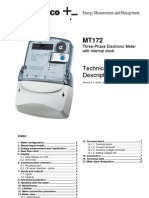Stand-Alone Microprocessor-Based Optical Data Acquisition System
Uploaded by
Apangshu DasStand-Alone Microprocessor-Based Optical Data Acquisition System
Uploaded by
Apangshu DasSTAND-ALONE MICROPROCESSOR-BASED OPTICAL DATA ACQUISITION SYSTEM A.R. A1-Ali, Ph.D. Assistant Prof.
, Department of Electrical Engineering King Fahd University of Petroleum and Minerals P.O.B. 323, Dhahran, 31261, Saudi Arabia E-MAIL: FACC109@SAUPMMOO.BINTNET
In this paper, the design of stand-alone optical data acquisition system is presented. The system hardware consists of an optical analog inputs, optical digital inputs, analog and digital inputs/outputs and Motorla MC68HCll microcontroller. The system software consists of several subroutines that enables the user through the input-driven-menu to read, store, analyze, process and display the incoming data. In addition to that, the user can select direction of the data, the number of analog or digital channels to be monitored, sampling rate per channel and the throughput rate. The user has the option of programming the unit itself for special application. The system is programmable, cheap, compact and versatile.
ing [l-51. A recent US patent 131 has been granted to the design of an optical analog to digital converter using optical and table look-up [l]. This presents paper integrated the optical and table loop-up approach with the microcontroller MC68HCll plus optical digital-to-analog converter and standard digital-to-analog and analog-to-digital converters which make complete stand-alone microprocessor-based optical data acquisition system. The system architecture shown in figure
1, is divided into five subsystems: An Optical
Optical sensing is one of the leading techniques in today's sensing technology. It has been used in signal processing, underwater acoustics, aerospace guidance and color sort-
analog and digital inputs, analog and digital inputs/outputs, microcontroller, input/output timers and communication ports. The first part of the inputs consists of sixteen channels Optical Analog-to-Digital Converters (OADCs) Each channel consists of optical emitter as tn"itter and detector as receiver. These sensors are interfaced via analog multiplexers to the analog inputs of the built-in eight channels analog-to-digital converter that is imbedded in the microcontroller [ 2 ] . The second part of the inputs consists of two eight-bit Optical Digital-to-Analog-Converters (ODACS). Each bit designed with emitter and
16 Pairs of Infrared Emitters and Detectors (Analog Sensors) V15
VI
.) = - . )
3 Input
Timers 5 Output Timers
VoH
+
VoB VoA
Figure 1. System Hardware Architecture.
1625
0-7803-0582-5/92$3.0001992 IEEE
detector. In addition to that an eight channel eight-bit standard analog-to-digital converters is interfaced to the microcontroller [1,2]. The microcontroller (MC68HCll) consists of eight channels standard,Analog-to-DigitalConverters (ADCs), 16Kbyte RAM, 2Kbyte EPROM, 512 byte EEPROM, seven input/output interrupt driven internal timers, Asynchronouns Communications Interface Adapter (ACIA) and RS232 to communicate with a host or terminal (Personal computer) with six different baud rate [2]. The output stage consists of eight channel Digital-to-Analog Converters (DACs) and eightbit bi-directional input/output ports. The software algorithm is written in a way that enables the user, through input driven-menu, to select, any analog, digital channel or channels to be monitored and recorded. With simple programi -7 ski.lls the user ia able to write his own subroutines to processes the input signals and make a desired decisions. The decision can be sent in analog or digital form. The system can be used as a real-time measurement unit in underwater acoustics, aerospace aviation, speech recognition and color sorting [1,8,9]. It can be used in neural network application where the sensors will act as input layer, the microcontroller and software as hidden layers and the DAC as an output layer [12]. The special feature of this system is its relatively low cost, a stand-alone system that does not require a host Computer to operate with once it is programmed, it can operate with different optical wavelengths where the user replaces the transmitter and receiver elements only, additionally it is in-house programmable for many tines as the user wants.
1 vcc
Figure 2. Analog infrared Emitter-Detecor Cell
As mentioned in the introduction there are sixteen optical pairs. These pairs are multiplexed via sixteen analog switches to the built-in eight channels analog-to-digital converter of the microcontroller MC68HCll. The range of the analog input should be between 0 to 5 Volts. The distance between the emitter and the detector is a very important matter in optical sensing. Table 1 shows the optimum distance between emitters and detectors [l]. Though this distance can be increased by pulsing the emitter rather than fixing the biasing [7].
Table 1. Transmission and reflective range of optical sensors [7] hnitter-Detector Pairs LED56&L14Ql Transmission Range
012"
Reflective Range
03."
1 1
m t i c a l a a l w-to-Diaital-Convert ers : The system has eight channels optical analog-to-digital converters. The basic building block of each channel is an optical light emitter as transmitter and optical light detector as a receiver (Figure 2). The emitter is a Light Emitting Diode (LED) and the receiver is phototransistor [7]. The operating wavelengths of both devices can be varied between 450-1000 Nanmeters. The gain and the offset of each cell can be adjusted with the three variable resistor that are shown in figure 2. RE will adjust the light intensity of the emitter, RD will adjust the analog voltage level at the output of the phototransistor. RO will adjust the DC offset that may result from the dark current or from interference from other adjacent optical channel. In addition to that, RE, RO and RD are used to adjust the current density of the emitter, the analog output level when the operation wavelength is changed by the user.
LED56LL41 LED55CLL14Gl IN6266&L14G3 F5D1&14G3
I I 1
018"
032" 048"
080" 200"
I I I
04.5"
08." 12" 20"
50"
I 1 1
F5Dl&L14P2
m i c a 1 Diaital gn_Duts/Ot&put
and -ertere
The system has 16-bit optical digital switches which can be used separately to read or write 8-bit transfers. Each bit consists of emitter and detector, three variable resistor and Schimtt trigger buffer (Figure 3). The output has two digital logic level, one is a high level (2.4-5.0 Volts) and the other is a low levei (3.0-0.SV). The functrGi1 G f &IC three variable resistor is the same as their function in the analog input. The optical digital switches are used as b a s ' c bcilding block of two eight-bit optical digital-toanalog converters. The output of these sixteen switches is directed to one or more of the eight digital-to-analog converters that will be described in the next section.
1626
1 vcc
as well as in single or continues scan mode. Single channel mode converts one channel only. Multiple-channel mode converts four channels simultaneously as a group. The single scan means one converting only and the ADC will not start conversion unless a software command is executed. On the other hand the scan mode means once the conversion is started, it will convert continuously one channel every 16 micro-sec.
mDUtS/oUtDl&
PrWr-1
e T
Figure 3. Digital lnfared Emitter-Detector Cell
S+andard-to-moa
Converters
A general purpose, single chip (DAC8800), eight channels eight-bit digital-analog converter is interfaced with one the microcontroller output port [a]. Both unipolar and bipolar output voltage are available. A threewire serial digital interface loads the contents of the eight internal DAC registers which establish the output voltage level. Figure 4 shows the basic building block of the DAC-8800 [ll].
The system has on-board eight programmable timers [2]. These timers are based on a free-running 16-bit counter with a four-stage programmable prescaler. The timer starts from a count of $0000 as the MCU is coming out of reset and then counts up continuously. When a maximum count is reached (SFFFF), the counter rolls over to a count of $0000. The eight timers are divided into three input capture timers and five output-capture timers. Each input and output timer has its own 16-bit register. These timers can be programmed to generate a hardware or a fix software interrupt at a fixed periodic rate for sequential conversion. The user can program each inputcapture function to detect edge polarity, measure a pulse width or a period of incoming signal. Such information can help t o start or stop conversion, to output an analog or digital single. Also the user can program the output-capture timers to generate a pulse or square wave upon receiving a sequence of optical signals via the OADCs or ODACs. More information on the timers operation can be found in reference 2.
P
Software package has been written in assembly language. It was divided into two section: User interface input driven-menu and real-time data acquisition. The interface subroutines enable the user to select the number of analog or digital channels to be monitored, sampling rate per channel, direction of the data, programming the input output timers and some. The data acquisition subroutines enable the user to read, store, and process the data. The main function of this data acquisition system is that it can be programmed in-house for special purposes.
SYSTEn FINAL FEATURES Ei SPECIFICA TIC??S
DAC5
v5
Figur 4. Block diagram of DAC-8800
Standard Analw to Diaital Converters
The built-in eight channels analog-todigital converters in the microcontroller are used as is [2]. They have been used as a basic building block in the OADCs. Sampling rate for the built-in ADC is 16 micro-sec per channel. Using the control register of the ADC, it can be setup for single or multiple-channel mode
1627
- -..
The system features and specifications can be summarized as follows: * 16 channels Optical Analog-to-Digital Converters. Resolution 8-bits (2omV/bit) * 8 channels standard Analog-to-DigitalConverter. Resolution 8-bits (20mV/bit) * 2 Optical-Digital-to-Analog Converters Resolution 8-bits (2OmV/bit) * 8 channels standard Digital-to-AnalogConverter.
* * * * *
8 TTL digital inputs/ outputs 8 programmable timers 16Kbyte RAM on-board memory
11. PMI, "Data Book of Analog Integrated Circuits," Vol. i o , pp 1 1 . 2 5 0 - 1 1 - 2 6 2 , 1 9 9 0 . 12. A1-Ali , Alakdhar & Al-Baiyat, "Neural Network Implementation Using MicroprocessorBased System," Second International Conf. on Automation. Robotics and C w uter Vision. Singapore, 1 9 9 2 .
8Kbyte EPROM on-board memory 512 byts EEPROM on-board memory Six programmable baud rate (Max: 9 6 0 0 , Min: 3 0 0 ) Sampling rate: 1 6 micro Sec. Software programmable
An optical stand-alone data acquisition system has been designed using an existing microcontroller [ 2 ] . The system was used in color sorting and proved to be accurate, reliable, cheap and compact. One disadvantage of the system the slow sampling rate and low voltage resolution. A new unit design is underway using MC68030 to overcome the sampling rate and resolution.
The author wishes to acknowledge the support of King Fahd University of Petroleum and Minerals.
1 . A. D. McAulay, Wptical Analog to Digital Converter Using Optical Logic and Table LoopUP I ODtical enoiDeering, Vol. No. 2 , pp 1141 2 9 , 29 Feb., 1 9 9 0 ,
2 . Motorola, 1988. WC68HCll
reference manual**,
3. A. D. Mcaulay, "Optical Analog to Digital US Patent No. 4 . 8 5 1 , 8 4 4 , 1 9 8 9 . convertert1,
4 . A. D. McAulay, aaOptical Neural Networks for Engineering Design,11 Nat'l aerosDace a n d c s conf,, Vol. 4 , pp 1302-1306, 1 9 8 8 . 5 . OMEGA TECH Company, "The Data Acquisition Systems Handbook , 1 9 9 0 .
Trends in Microcom6 . B. K. Bose. llTechnology puter Control of Electrical Machines,I1 LggE 3 Vol. , 35, 1601 7 7 , Feb. 1 9 8 8 .
7. Harris semiconductors, I1Optical electronics data bookt1,1 9 9 1 .
S. Barua, llHigh-Speed, Multiplier for 8. Digital Signal processing,11 Enaineer U ,Val 30 No. 1 2 , pp 1997-2002, Dec. 1 9 9 1 .
9. B. Javidi, nIndustrial Application of optical signal Processing I , 1 a QDtical Xngk neering, Vol. 27 No. 4, pp 2 5 7 . April 1 9 8 8 .
1 0 . P. R. Norton, "Infrared Image Sensors , ODtical w e e r i n g , Vol. 30 No. 1 1 , pp 16491 6 6 3 , Nov. 1 9 9 1 .
1628
You might also like
- EPA07 Maxxforce 11, 13 Engine Service Manual79% (29)EPA07 Maxxforce 11, 13 Engine Service Manual490 pages
- Gideon's Guardians - New Meth Recipe - A - K - A Easter Bunny Meth67% (6)Gideon's Guardians - New Meth Recipe - A - K - A Easter Bunny Meth50 pages
- DIY: Immobilizer Hacking For Lost Keys or Swapped ECU50% (4)DIY: Immobilizer Hacking For Lost Keys or Swapped ECU14 pages
- Isuzu NPR - NPR HD - NQR Commercial Truck Tiltmaster Service Manual Supplement 200383% (6)Isuzu NPR - NPR HD - NQR Commercial Truck Tiltmaster Service Manual Supplement 2003215 pages
- X32 Matrix Setup Guide: Step 1: Assign The Matrix Mix To An OutputNo ratings yetX32 Matrix Setup Guide: Step 1: Assign The Matrix Mix To An Output2 pages
- Research Inventy: International Journal of Engineering and ScienceNo ratings yetResearch Inventy: International Journal of Engineering and Science10 pages
- Embedded Systems Using 8051 MicrocontrollerNo ratings yetEmbedded Systems Using 8051 Microcontroller36 pages
- Wireless M-Bus Protocol For Advanced Metering InfrastructureNo ratings yetWireless M-Bus Protocol For Advanced Metering Infrastructure38 pages
- Acharya Institute of Technology Broadband Over Power Line: Title of The ProjectNo ratings yetAcharya Institute of Technology Broadband Over Power Line: Title of The Project24 pages
- Computing Machinery: Chapter 10: MicrocontrollersNo ratings yetComputing Machinery: Chapter 10: Microcontrollers51 pages
- National Institute of Technology, Rourkela: Embedded Systems LaboratoryNo ratings yetNational Institute of Technology, Rourkela: Embedded Systems Laboratory13 pages
- Gokaraju Rangaraju Institute of Engineering and Technology (Autonomous) Project ReportNo ratings yetGokaraju Rangaraju Institute of Engineering and Technology (Autonomous) Project Report28 pages
- Dual Glucose Cholesterol Meter ApplicationsNo ratings yetDual Glucose Cholesterol Meter Applications4 pages
- DC Motor Speed Control Using Pulse Width Modulation (PWM)No ratings yetDC Motor Speed Control Using Pulse Width Modulation (PWM)30 pages
- Micro Controller Based Traffic Light Controller: Er. Sunimerjit Kaur100% (1)Micro Controller Based Traffic Light Controller: Er. Sunimerjit Kaur26 pages
- Design of Handheld Oscilloscope Based On FPGA and Dual A/D: Hu Yang, Yuduo WangNo ratings yetDesign of Handheld Oscilloscope Based On FPGA and Dual A/D: Hu Yang, Yuduo Wang7 pages
- Implementation of PIC Based Digital Frequency CounterNo ratings yetImplementation of PIC Based Digital Frequency Counter4 pages
- Design and Micro Controller Implementation of A Three Phase SCR Power ConverterNo ratings yetDesign and Micro Controller Implementation of A Three Phase SCR Power Converter8 pages
- International Journal of Computational Engineering Research (IJCER)No ratings yetInternational Journal of Computational Engineering Research (IJCER)4 pages
- Communication Antenna Switching System Based On Micro ControllerNo ratings yetCommunication Antenna Switching System Based On Micro Controller4 pages
- A Mixed-Signal Sensor Interface MicroinstrumentNo ratings yetA Mixed-Signal Sensor Interface Microinstrument12 pages
- Dire Dawa University Institute of TechnologyNo ratings yetDire Dawa University Institute of Technology28 pages
- Ijert Ijert: Lighting Control System Using Power Line Communication NetworkingNo ratings yetIjert Ijert: Lighting Control System Using Power Line Communication Networking7 pages
- Pourquoi Utilser Signal Conditioner LS7084No ratings yetPourquoi Utilser Signal Conditioner LS70844 pages
- GPS-GSM Integration For Enhabcing Public Transportation Management ServicesNo ratings yetGPS-GSM Integration For Enhabcing Public Transportation Management Services26 pages
- Eng-Design of Open Architecture Ship-M.S. ZaghloulNo ratings yetEng-Design of Open Architecture Ship-M.S. Zaghloul20 pages
- Deepakembeddedsystems 140102132829 Phpapp01No ratings yetDeepakembeddedsystems 140102132829 Phpapp0125 pages
- SCADA - Topic - 2 - Updated (SCADA Hardware and Firmware)No ratings yetSCADA - Topic - 2 - Updated (SCADA Hardware and Firmware)75 pages
- Railway Accident Monitoring System: A Project Report ONNo ratings yetRailway Accident Monitoring System: A Project Report ON13 pages
- Data Procurement and Control Associated Online SystemNo ratings yetData Procurement and Control Associated Online System5 pages
- Gideon's Guardians - New Meth Recipe - A - K - A Easter Bunny MethGideon's Guardians - New Meth Recipe - A - K - A Easter Bunny Meth
- DIY: Immobilizer Hacking For Lost Keys or Swapped ECUDIY: Immobilizer Hacking For Lost Keys or Swapped ECU
- Isuzu NPR - NPR HD - NQR Commercial Truck Tiltmaster Service Manual Supplement 2003Isuzu NPR - NPR HD - NQR Commercial Truck Tiltmaster Service Manual Supplement 2003
- X32 Matrix Setup Guide: Step 1: Assign The Matrix Mix To An OutputX32 Matrix Setup Guide: Step 1: Assign The Matrix Mix To An Output
- Research Inventy: International Journal of Engineering and ScienceResearch Inventy: International Journal of Engineering and Science
- Wireless M-Bus Protocol For Advanced Metering InfrastructureWireless M-Bus Protocol For Advanced Metering Infrastructure
- Acharya Institute of Technology Broadband Over Power Line: Title of The ProjectAcharya Institute of Technology Broadband Over Power Line: Title of The Project
- National Institute of Technology, Rourkela: Embedded Systems LaboratoryNational Institute of Technology, Rourkela: Embedded Systems Laboratory
- Gokaraju Rangaraju Institute of Engineering and Technology (Autonomous) Project ReportGokaraju Rangaraju Institute of Engineering and Technology (Autonomous) Project Report
- DC Motor Speed Control Using Pulse Width Modulation (PWM)DC Motor Speed Control Using Pulse Width Modulation (PWM)
- Micro Controller Based Traffic Light Controller: Er. Sunimerjit KaurMicro Controller Based Traffic Light Controller: Er. Sunimerjit Kaur
- Design of Handheld Oscilloscope Based On FPGA and Dual A/D: Hu Yang, Yuduo WangDesign of Handheld Oscilloscope Based On FPGA and Dual A/D: Hu Yang, Yuduo Wang
- Implementation of PIC Based Digital Frequency CounterImplementation of PIC Based Digital Frequency Counter
- Design and Micro Controller Implementation of A Three Phase SCR Power ConverterDesign and Micro Controller Implementation of A Three Phase SCR Power Converter
- International Journal of Computational Engineering Research (IJCER)International Journal of Computational Engineering Research (IJCER)
- Communication Antenna Switching System Based On Micro ControllerCommunication Antenna Switching System Based On Micro Controller
- Ijert Ijert: Lighting Control System Using Power Line Communication NetworkingIjert Ijert: Lighting Control System Using Power Line Communication Networking
- GPS-GSM Integration For Enhabcing Public Transportation Management ServicesGPS-GSM Integration For Enhabcing Public Transportation Management Services
- Eng-Design of Open Architecture Ship-M.S. ZaghloulEng-Design of Open Architecture Ship-M.S. Zaghloul
- SCADA - Topic - 2 - Updated (SCADA Hardware and Firmware)SCADA - Topic - 2 - Updated (SCADA Hardware and Firmware)
- Railway Accident Monitoring System: A Project Report ONRailway Accident Monitoring System: A Project Report ON
- Data Procurement and Control Associated Online SystemData Procurement and Control Associated Online System
- Analog Dialogue, Volume 45, Number 4: Analog Dialogue, #4From EverandAnalog Dialogue, Volume 45, Number 4: Analog Dialogue, #4
- Analog Dialogue, Volume 48, Number 1: Analog Dialogue, #13From EverandAnalog Dialogue, Volume 48, Number 1: Analog Dialogue, #13

























































































